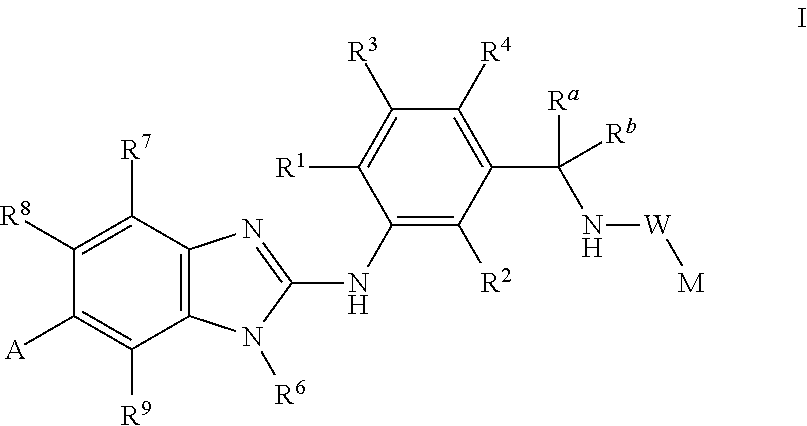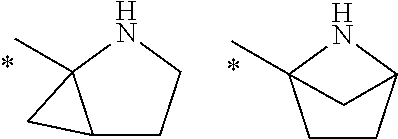Novel compounds
a technology of compounds and compounds, applied in the field of new compounds, can solve the problems of adverse biological effects, gastrointestinal side effects, and reduced formation of all metabolites, and achieve the effects of affecting platelet and renal function, and reducing the formation of all metabolites
- Summary
- Abstract
- Description
- Claims
- Application Information
AI Technical Summary
Problems solved by technology
Method used
Image
Examples
example 1
2-Amino-N-{4-chloro-3-[5-chloro-1-methyl-6-(3-(trifluoromethyl)piperidin-1-yl)-1H-benzo[d]imidazol-2-ylamino]benzyl}-3,3,3-trifluoro-2-methylpropanamide
[0359]
(a) Tert-butyl 4-chloro-3-nitrobenzylcarbamate
[0360]TEA (3.12 mL, 22.4 mmol) followed by DMAP (0.14 g, 1.1 mmol) were added to (4-chloro-3-nitrophenyl)methanamine hydrochloride (5.00 g, 22.4 mmol) in DCM (30 mL). The mixture was cooled to 0° C. and BOC-anhydride (5.87 g, 26.9 mmol) in DCM (15 mL) was added. After stirring at 0° C. for 30 min and further 18 h at rt the reaction mixture was poured into ammonia (10%). The mixture was extracted with DCM. The combined extracts were washed with brine, dried over Na2SO4 and concentrated to give the sub-title compound.
[0361]Yield: 5.66 g (88%). Rf(TLC): 0.75 (silica gel, DCM:EtOH 98:2)
(b) Tert-butyl 3-amino-4-chlorobenzylcarbamate
[0362]Sat. aq. NH4Cl (50 mL) followed by iron powder (5.51 g, 98.7 mmol) were added at rt to a mixture of tert-butyl 4-chloro-3-nitrobenzylcarbamate (5.66 g, ...
example 2
N-{4-Chloro-3-[6-chloro-5-(3,3-difluoropyrrolidin-1-yl)-1H-benzo[d]imidazol-2-ylamino]benzyl}-2,2-dimethyl-propionamide
[0379]
(a) N-(4-Chloro-3-nitrobenzyl)-2,2-dimethyl-propionamide
[0380]TEA (8.00 mL, 57.5 mmol) followed by pivaloyl chloride (2.80 mL, 22.8 mmol) in THF (25 mL) were added to 4-chloro-3-nitrobenzylamine hydrochloride (5.00 g, 22.4 mmol) in THF (100 mL). The reaction mixture was diluted with THF and stirred at rt for 1.5 h. The mixture was filtered and washed. The filtrate was concentrated to give the sub-title compound.
[0381]Yield: 5.92 g (98%). HPLC-method A: Rf=1.911 min. MS m / z: 271 [M+H]+.
(b) N-(3-Amino-4-chlorobenzyl)-2,2-dimethyl-propionamide
[0382]A mixture of N-(4-chloro-3-nitrobenzyl)-2,2-dimethyl-propionamide (5.92 g, 21.9 mmol), THF (150 mL) and Ra—Ni (1.50 g) was stirred for 2 days at RT under a hydrogen atmosphere (3.0 bar). The catalyst was removed by filtration and the mixture was concentrated. The crude was purified by chromatography to give the sub-tit...
example 3
N-{4-Chloro-3-[5-chloro-6-(3-dimethylaminomethyl-pyrrolidin-1-yl)-1H-benzimidazol-2-ylamino]-benzyl}-2,2-dimethyl-propionamide
[0394]
(a) 4-Chloro-5-(3-dimethylaminomethyl-pyrrolidin-1-yl)-2-nitroaniline
[0395]Potassium carbonate (500 mg, 3.6 mmol) was added to a mixture of 3-dimethylaminomethyl-pyrrolidine (450 mg, 3.5 mmol) and 4,5-dichloro-2-nitroaniline (500 mg, 2.4 mmol) in DMSO (5 mL). The reaction mixture was stirred at 120° C. overnight, diluted with EtOAc and washed with water and brine. The organic layer was dried over Na2SO4 and concentrated.
[0396]Yield: 630 mg (87%). Rf(TLC): 0.15 (silica gel, DCM:EtOH 95:5). HPLC-method B: Rt=1.28 min. MS m / z: 299 [M+H]+.
(b) 4-Chloro-5-(3-dimethylaminomethyl-pyrrolidin-1-yl)-benzene-1,2-diamine
[0397]A mixture of 4-chloro-5-(3-dimethylaminomethyl-pyrrolidin-1-yl)-2-nitroaniline (630 mg, 2.1 mmol), EtOAc (20 mL) and Ra—Ni (150 mg) was stirred for 2 days at rt under a hydrogen atmosphere (3.0 bar). The catalyst was removed by filtration and t...
PUM
| Property | Measurement | Unit |
|---|---|---|
| Fraction | aaaaa | aaaaa |
| Temperature | aaaaa | aaaaa |
| Molar density | aaaaa | aaaaa |
Abstract
Description
Claims
Application Information
 Login to View More
Login to View More - R&D
- Intellectual Property
- Life Sciences
- Materials
- Tech Scout
- Unparalleled Data Quality
- Higher Quality Content
- 60% Fewer Hallucinations
Browse by: Latest US Patents, China's latest patents, Technical Efficacy Thesaurus, Application Domain, Technology Topic, Popular Technical Reports.
© 2025 PatSnap. All rights reserved.Legal|Privacy policy|Modern Slavery Act Transparency Statement|Sitemap|About US| Contact US: help@patsnap.com



